Saskatoon Transit
Saskatoon Transit (formerly Saskatoon Municipal Railway) is the public transport arm of the City of Saskatoon, Saskatchewan, Canada. It operates a fleet of diesel buses. A total of 23 bus routes serve every area of the city, carrying approximately 11 million passengers in 2008.[1] Saskatoon Transit is a member of the Canadian Urban Transit Association. The major bus terminal is located Downtown.
 | |
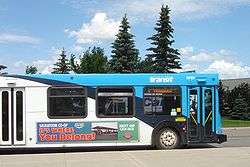 | |
| Founded | 1913 |
|---|---|
| Headquarters | 301 24th Street West |
| Locale | Saskatoon, SK |
| Service area | Saskatoon |
| Service type | bus service, paratransit, bus rapid transit, light rail transit (planned) |
| Routes | 46 |
| Fleet | 188 buses[1] including 110 low-floor, (included in the 110 are 9 low-floor 60-foot articulated buses, 6 twenty-one passenger shuttle buses and 8 hybrid |
| Annual ridership | 11 million[1] |
| Fuel type | Diesel |
| Operator | City of Saskatoon |
| Website | Saskatoon Transit |
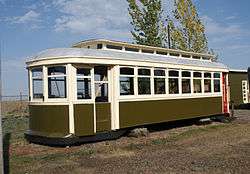
History
Saskatoon Transit was initially known as Saskatoon Municipal Railway and began operating on January 1, 1913 with a fleet of streetcars.[2][3] Service as far as Sutherland began in 1914 when it was still a separate village.[3] The servicing garage was (and remains) located in the Caswell Hill neighbourhood, on the north side of 24th Street between Avenues C and D. (A second garage now faces it across 24th Street.)
The central transfer point for most bus routes has always been the block of 23rd Street between 2nd and 3rd Avenues and the neighbouring corners on 2nd and 3rd Avenues. In 1984, this block was permanently closed to regular traffic and a "Transit Terminal" constructed, consisting of widened sidewalks, heated shelters, and angled curbs to provide three "bays" on each side of the block. The 23rd Street Transit Terminal was opened on November 2, 1984.[3] This terminal area is perceived by many as unsafe, and most of the businesses along this block have relocated; however, Saskatoon Transit has made some recent improvements, including a constant security guard presence and a Customer Service Centre where tickets, passes and schedules may be obtained. The 2005 Strategic Plan Study recommended that major improvements be carried out to the downtown terminal, but as of 2007 no changes have been made.
Diesel buses supplemented the streetcar service from at least 1938. In the 1940s a decision was made to replace streetcar service with trolley buses; the first trolley bus ran on November 22, 1948, starting a three-year transition period, and the last streetcar ran on November 10, 1951. With the demise of the streetcars, Saskatoon Municipal Railway was renamed Saskatoon Transit System on August 15, 1949. The trolley buses were in turn phased out and ran for the last time on May 10, 1974.[2]
Although the official name is now Saskatoon Transit Services (as of 1998), it is generally known simply as Saskatoon Transit, which is what appears on their Web page, logo, and all their brochures.
Two of the original Saskatoon streetcars are on display and being restored at the Saskatchewan Railway Museum.
2005 Strategic Plan Study
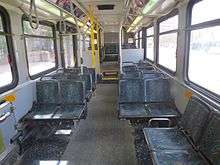
A comprehensive study[4] of Saskatoon Transit's service was undertaken in 2005, outlining many deficiencies and making many recommendations. Transit ridership had fallen from 12.4 million passengers in 1987 to 7.2 million passengers in 2005, while the city's population increased from 182,000 to 214,000. The conclusions of the study were summarised in a Short Term Plan and a Long Term Plan. Most of the recommendations of the Short Term Plan have been implemented, and the Long Term Plan is being carried out, subject of course to funding and other considerations.
The main recommendations of the Short Term Plan were to re-orient the current regular service network to better serve the University of Saskatchewan and other key destinations, to introduce higher-order "DART" service on four corridors interlined into two routes, and to construct a new bus terminal at Market Mall, as well as to make major improvements to the terminals downtown and at the University.
The routes in place prior to 2006 had not been substantially modified since the 1970s, and some since the 1950s, with the result that many neighbourhoods, particularly the newer suburbs, had poor service. Some areas such as Montgomery Place and Briarwood had no bus service at all on weekends. Many outlying neighbourhoods (e.g., Dundonald, Silverspring, Briarwood) had "stub routes" that deposited riders at a suburban mall transfer point, necessitating a transfer, and often two or three, to get anywhere in the city. Post-secondary institutions were under-served relative to the number of students using the buses; SIAST Kelsey Campus had only one major route serving it, so that trips to SIAST from most places in Saskatoon involved a transfer onto an overcrowded bus. Due to extreme congestion at the University of Saskatchewan, several routes bypassed the campus altogether, forcing students to cross College Drive on foot. Service to the airport was nonexistent, and service to industrial areas was extremely poor. Demand in these areas was also extremely low, at least in part due to the poor service.
The Market Mall terminal has been built, and a temporary terminal with car traffic prohibited has been built at the University, pending a longer-term solution. Work has yet to begin on improving or relocating the downtown terminal.
The Long Term Plan is a 10-year plan that focuses on the infrastructure needed to maintain the improvements to the system implemented in the Short Term Plan and expansion needed to keep up with the expected increases in ridership that the improvements will generate. Issues include staffing, fleet replacement, refurbishing older buses, maintenance, new technologies such as emissions reduction and "smart" fare collection. Critical items include:
- Rejuvenating the fleet. The industry standard is to replace buses on an 18-year cycle; by this standard, Saskatoon Transit's fleet is quite old. The plan recommends replacing 6 buses a year through 2010, and 7 buses a year for the remaining years of the plan, as well as expanding the fleet by 12 buses.
- New transit garage. The current transit garage is too small for the fleet and surrounded by residential properties that make it undesirable if not impossible to expand the facility. A satellite facility or entirely new facility in a different location, probably an industrial park, is recommended within the next 5 years.
- More bus shelters. The plan recommends a target number of 215 bus shelters (30% of stops), or 22 per year over the course of the plan, up from 3 or 4 per year that are currently installed.
- Fare technology. A review of fare collection options, and in particular smart card technology, should be undertaken within a year.
- Transit-oriented development. Work with urban planners to design neighbourhoods that work with public transit and discourage use of private vehicles.
- Signal priority and queue-jump lanes. Allow buses to avoid congestion by "turning the lights green" for them, and providing bus-only lanes where needed, for instance at the approaches to University Bridge.

2015 Lockout
After failing to arrive at a mutual agreement upon a new contract (which bus drivers have not had since 2012), the City of Saskatoon locked out the bus drivers while negotiations continued.
Fares

Fares may be paid by the Go-Pass smart card, or cash (coins only effective February 2010). The adult cash fare is currently $3.00 (as of Feb 2016), which includes unlimited transfers for 90 minutes from time of payment. Primary and secondary school students pay reduced fares.
Seniors are eligible for discounted passes lasting 3 months to a year. Riders on social assistance are also eligible for discounted monthly passes.
Post-secondary students
University of Saskatchewan undergraduate students pay a mandatory U-PASS fee (currently $69.50 per term) for a universal transit pass, in the form of a validation sticker on their student card. Students living in on-campus residences and others with special circumstances may apply for an exemption.
Other post-secondary students may purchase a 4-month semester pass at a slightly reduced price compared to the adult monthly pass.
Go-Pass
Effective February 2010, Saskatoon Transit has upgraded its fare system to use a smart card system called Go-Pass. The card has replaced tickets, day passes and monthly passes, respectively with a refillable fare card and unlimited-fare cards that expire after a day or month. The system cost Saskatoon Transit $2.9 million. The system's roll-out date was delayed to February 2010 in order to avoid problems with the new system during the 2010 World Junior Ice Hockey Championships.
Smart cards have been adopted to limit fraud—such as forged monthly passes and short-changed fares—and to reduce the potential for conflict between driver and passenger. Rather than showing the card to the driver, the card is swiped across the reader and may remain inside a wallet. Transfers are barcoded and scanned when a passenger boards. The new fare boxes do not accept bills, but coins are accepted and the values displayed to both rider and driver.
Routes
Route names
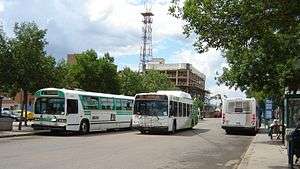
The names next to each route number are displayed on the front of each bus.
- 101 University Direct
- 102 University Direct
- 1 Exhibition – City Centre
- 2/10 Meadowgreen – City Centre
- 3 Hudson Bay Park – City Centre
- 4/43 City Centre – Evergreen
- 4/44 City Centre - Willowgrove
- 4/45 City Centre - Arbor Creek
- 5 McCormack – City Centre
- 6 Broadway
- 6 Market Mall
- 7 Dundonald – City Centre
- 8/81 Centre Mall – University
- 8/82 Centre Mall - University
- 8/83 Stonebridge - City Centre
- 8/84 Centre Mall - Briarwood
- 8/86 Centre Mall - Rosewood
- 82 U of S
- 9 Riversdale – City Centre
- 11 Airport - City Centre
- 12 River Heights – City Centre
- 13 Lawson Heights – Broadway
- 13 U of S
- 14 North Industrial
- 15 Civic Operations Centre
- 16 Stonebridge - University
- 17 U of S
- 18 College Park – University
- 19 Centre Mall – City Centre
- 20 South Industrial – City Centre
- 21 University
- 22 City Centre - Confederation
- 25 SaskTel Centre
- 26 Forest Grove - University
- 26 U of S
- 27 Silverspring - University
- 30 Lawson Heights - City Centre
- 35 Silverwood Heights - City Centre
- 50 Lakeview - University
- 53/82 U of S
- 55 Lakeridge - University
- 60 Confederation – University
- 61 Blairmore - University
- 62 Montgomery - University
- 63 Hampton Village - University
- 64 Kensington - University
After waiting in queue for months, the city of Saskatoon will partner with Google Transit to provide an online mapping website. This interface will take the routes and city schedules currently available and google maps will then calculate for the website viewer the optimal connection for transport between two addresses and the time to be at the designated bus stop for bus service.[5][6]
DART (Direct Access Rapid Transit)
DART is Saskatoon Transit's planned bus rapid transit service. The four DART routes will interline in the central sections to form two corridors with extremely frequent service. Along this portion of their routes, bus stops will be widely spaced to increase speed, and there will be "express" sections on each route with no stops for over a kilometre. The interlined routes 50/60 will run from Confederation Mall to The Centre via downtown and the University of Saskatchewan, and routes 70/80 will run from The Mall at Lawson Heights to the University Heights Suburban Centre via SIAST Kelsey Campus, downtown and the University. The routes will continue past these points, each serving a residential loop at either end (a total of 8 loops). Low floor buses will be used on the DART routes. Some of these buses will be air-conditioned and all will have bicycle racks on the front. Construction is planned to begin 2022.[7]
Regular and commuter routes
There are 46 bus routes serving Saskatoon, 32 of which are full service.[8] About a third of the buses serving the city are now low-floor. Most have a blue livery. Many routes meet at the downtown terminal (except 13, 17, 21, and 25, all of which serve the University Terminal.) As well as full service routes there are also peak only routes. Some only operate in one direction at a time, either towards the downtown or the University in the morning, or towards their respective terminals in the afternoon. Others run both directions, but hourly during the peak hours only.
Combined routes
Some buses change their route number at their terminals, which is also known as a "stay-in-seat transfer" because the passengers do not have to leave the bus when it changes to the different route. The list of these "transfers" is as follows:
- 1 Exhibition becomes 7 Dundonald at Downtown Terminal
- 9 Riversdale becomes 3 Hudson Bay Park at Downtown Terminal
- 3 Hudson Bay Park becomes 9 Riversdale at Downtown Terminal
- 7 Dundonald becomes 1 Exhibition at Downtown Terminal
- 12 River Heights becomes 19 Centre Mall via Lorne Avenue at Downtown Terminal
- 19 City Centre via Market Mall becomes 12 River Heights at Downtown Terminal
- 5 McCormack becomes 15 Civic Operations Centre at Downtown Terminal
- 15 Civic Operations Centre becomes either 10 Pleasant Hill or 5 McCormack (every 15 mins alternately)
- 18 College Park becomes 55 Lakeridge at Place Riel
- 55 Lakeridge becomes 18 College Park at Place Riel
- 50 Lakeview becomes 17 Stonebridge at Place Riel (ONLY DURING PEAK HOURS)
- 86 Rosewood becomes 84 Briarwood at Centre Mall Terminal. 84 Briarwood completes one full ride from Centre Mall then becomes 8 City Centre again
- 60 Confederation becomes 63 Hampton Village at Place Riel
- 63 Hampton Village becomes 65 Kensington at Place Riel
- 65 Kensington becomes 60 Confederation at Place Riel
- (On weekends and holidays only): Route 65/63 approach Confederation Terminal, then ride through Kensington, Confederation, Hampton Village, Blairmore areas before coming back to Confederation Terminal and ride back to Downtown.
Other services
School service, special events, charter
Saskatoon Transit operates special morning and afternoon service to many of the city's schools, and also serves events at SaskTel Centre. Buses are also available for charter trips within 40 km of the city centre. Special routes which are available to the general public have route numbers in the 300-series, with route 399 being the SaskTel Centre special from the downtown terminal. SaskTel Centre sometimes offers charter service from locations other than the downtown, but because these are charter services which regular fare, passes and transfers do not apply, these do not have route numbers.
Access Transit
Access Transit is a shared-ride door-to-door service for people who are unable to use regular transit services. Passengers are required to register in the system and book their trips in advance, either on a per-trip basis or as a regularly scheduled "subscription trip". Fares and payment are the same as for regular transit service. Access Transit in Saskatoon has been used as a model for other cities in Canada and the United States.
Fleet
Saskatoon Transit's fleet consists almost exclusively of 40-foot (12 m) diesel buses, of which there are approximately 120 in service. Saskatoon also has 3, 60-foot (18 m) articulated buses made by Nova Bus. The 76 buses acquired since 1995 are New Flyer low-floor buses; these now make up more than half the fleet. Eight of the low-floor buses are hybrid electric. 90 buses are required for peak hour service commitments.[4]
In fall 2009, a tender for 3 articulated buses was awarded to Nova Bus. These buses were delivered in April 2010 and officially unveiled at a press conference in front of city hall in June 2010. In 2014, several buses were taken in for maintenance. in September, just before the buses was re-entering service (while the bus driver was getting coffee) he/she left one of them running when a kid discovered it and took it on a 10-meter joyride before hitting another bus that was also re-entering service, causing both to go back into maintenance.
Saskatoon Transit announced that a 100% low-floor fleet would be achieved by the end of 2018, meaning the retirement of the 6 remaining Classic high-floor buses. 371 (New Look) and 449 (Classic) are preserved and restored.

- A New Flyer D40LFR, painted in Saskatoon Transit's DART paint scheme, with bike carrier, received in 2006.
- A New Flyer DE40LFR, a diesel-electric hybrid, painted in the current paint scheme, with bike carrier, received in 2008.
Transit Terminal
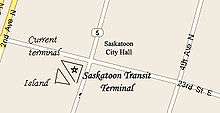
On July 16, 2008, Saskatoon city council authorised a $4.2 million transit terminal to be constructed on a parking lot adjacent to the current on-street terminal. The new terminal would centre around a 600 square meter LEED-certified building with a green roof, surrounded by a ring of raised-platform stops. In addition to Saskatoon Transit, the building could also house a coffee shop and government offices such as social services or immigration.[9]
Bus barn re-location
City Transit Bus Routes has housed its headquarters around the 1913 original streetcar building at Avenue C and 24th Street. The city transit headquarters afterwards adopted this area for bus warehouse garages and offices between Avenue C and D at 24th Street. A seven million dollar consultant plan has been approved by the Saskatoon planning and operations committee to relocate the transit bus barns. The Caswell neighbourhood will be revitalised by renovating the 13-acre (53,000 m2) area with a community for artists and musicians enhanced with a music festival.
See also
| Wikimedia Commons has media related to Saskatoon Transit. |
- Saskatchewan Railway Museum – Saskatoon Street Cars
References
- Saskatoon Transit Unveils New Smart Card System, Dec 2009.
- David A. Wyatt, Transit History of Saskatoon, Saskatchewan, 1989–2007.
- City of Saskatoon Archives. Significant Dates: A Saskatoon Chronology Archived 2007-02-05 at the Wayback Machine, 1999–2006.
- IBI Group. Saskatoon Transit Strategic Plan Study Archived 2007-04-10 at the Wayback Machine, Saskatoon Transit, October 2005.
- Noakes, Darrell (March 19–25, 2010). "Google Transit Coming Bus Routes Soon Available Via Google Maps" (page 2)
|format=requires|url=(help). VerbNews.com. Missing or empty|url=(help) - "Routes & Schedules | Transit.Saskatoon.ca".
- "Transit Plan". 2017-10-12.
- "Routes & Schedules | Transit.Saskatoon.ca".
- Nickel, Rod (July 17, 2008). "Council supports transit terminal". Saskatoon StarPhoenix. pp. A3. Archived from the original (– Scholar search) on November 4, 2012.